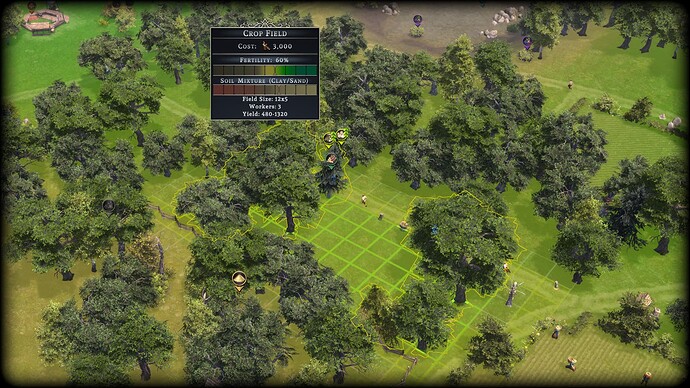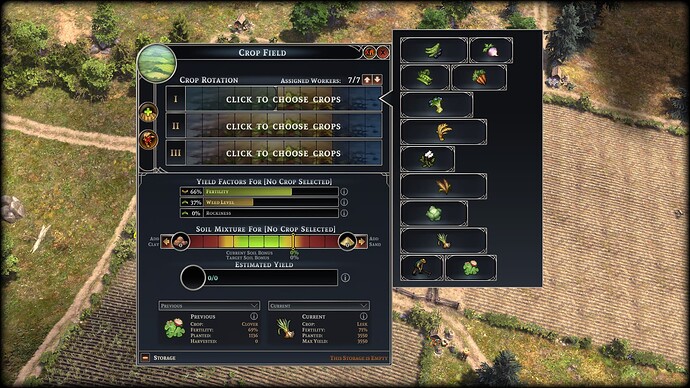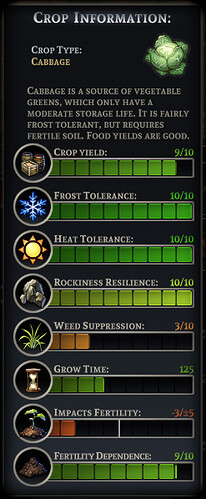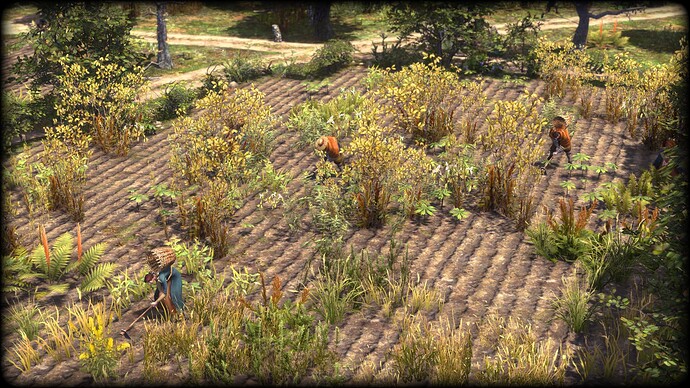Journey Log #03, we have broken new ground and established our settlement. Foragers are ensuring a steady supply of food. The wolves ate Jasper…
Welcome to the Farthest Frontier.
Your settlement has endured the harsh winter, the first year in the frontier is now behind you. The essentials are provided for as your people look to the future. A growing populace requires substantial food stocks, more than just foraging for berries and hunting can provide. One answer to this predicament is agriculture.
![]() Working the Earth
Working the Earth
Crop Fields are a significant investment. Planning ahead is important; but the return is well worth it once your villagers are harvesting a variety of vegetables. Farming is also one of the most advanced parts of Farthest Frontier’s simulation, rooted firmly in historic farming logistics.
When placing a Crop Field, you will want to pay close attention to the surrounding fertility. The environment you are planting in can have a dramatic impact on future success. While it is possible to improve the land’s fertility over time, a barren wasteland not only has low starting fertility but will also gain fertility more slowly.
Once a location is designated for planting, a Crop Field needs to be prepared by farmers. Any debris, such as rocks and trees, must be cleared out and then the ground needs to be tilled. The entire process takes a significant amount of time and can take years if the terrain is difficult. Work also halts once it gets too cold and the soil too hard from freezing winter temperatures. As you can expect, a larger field has a larger work area and takes proportionally longer.
![]() Crop Rotations
Crop Rotations
After some arduous labor, the field is ready for planting. You can now select what crops to plant from its UI. Crop fields work on a 3-year rotation, with each line indicating what crops are planted in what order that year. When a new year starts, the next line in the rotation begins.
A crop rotation allows you to grow different crops on the same field, but more importantly, it is an opportunity to fine-tune the fertility and weed suppression of the field. Each crop has a different impact on the soil, which should be considered when setting up a rotation. Some crops handle heat better, while others require cooler temperatures. Some crops have very high yield, but might take most of the planting season to grow, leaving little time for growing anything else.
Unlike most crops, grains cannot be eaten directly after harvest and must be further processed in a wind mill, and the resulting flour baked in a bakery.
While wheat has a very high yield compared to other grains, it is more sensitive to fertility level and also depletes fertility faster than many other crops. Wheat can also be affected by some severe diseases.
Crops also have varying shelf life, with leafy greens spoiling more readily than grains and root vegetables, a factor worth considering when storing food for short-term and long-term consumption.
Plant too many crops that drain the soil of nutrients without balancing them out with nitrogen fixing plants, and you will soon be left with a barren patch of dirt.
![]() Field Maintenance
Field Maintenance
A freshly-tilled field, no matter where it is placed, has to contend with rocky soil and weeds. These factors reduce harvest as the desired plants are choked out by poor soil and fast-growing weeds.
While some crops are resilient and can handle rocky soil, and some even suppress weed growth, care must be taken to keep fields at their peak, or to improve the state of the soil.
Field Maintenance is a task that can be assigned to the crop rotation. During maintenance, rather than planting crops, farmers will work the earth to remove weeds and rocks. Over time, this process dramatically improves the soil, but weeds will inevitably return if a field isn’t maintained periodically.
![]() Poop…er…Compost
Poop…er…Compost
By virtue of living, humans and animals generate waste. This waste takes many forms, from the manure cattle produce to the waste products leftover from meals.
If not collected, waste can accumulate, increasing risk of disease and attracting rats. The Compost Yard turns this problem into an opportunity. Beyond clearing waste from homes and gathering it from livestock, the nightsoil collectors perform another duty at this structure, and that is to produce compost.
It takes a significant amount of time to gather enough compostable waste and to allow it to decompose into compost, but once ready it can be added to your crop fields to provide a bonus to soil fertility, which in turn yields bigger harvests. Compost is another excellent way to sustain healthy crop growth by returning lost nutrients to the earth.
![]() Old Timey Diseases but for Crops
Old Timey Diseases but for Crops
While nature’s bounty is plentiful, it can also be cruel. Planted crops can be eaten by wildlife, rot if not harvested at the right time, or develop diseases. Diseased crops suffer from severely reduced yields as the plants are ravaged by fungus, pests and parasites.
In Farthest Frontier’s times, often very little can be done to save a harvest once a field is infected, but further damage can be mitigated by rotating to crops not impacted by the disease and ensuring that nearby fields are not growing the same crops, lest the disease spread further and cripple those harvests as well.
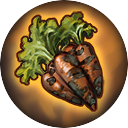



Diseases do not strike suddenly but instead accumulate in the soil over time, so sufficiently spacing out crops that are susceptible to the same disease can often prevent severe outbreaks.
Farming is one of Farthest Frontier’s deepest and most rewarding mechanics. A selection of 10 crops offers great flexibility and opportunity to customize their fields as they see fit and we look forward to seeing what strategies emerge when Farthest Frontier goes into Early Access!
Eager to learn more about Farthest Frontier? Check back on 05/23/2022 for the next Journey Log!

